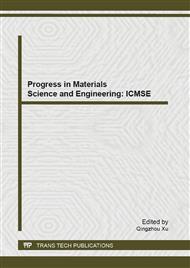p.287
p.293
p.299
p.305
p.312
p.317
p.321
p.325
p.329
Research on Protecting the Silk Fabrics from Fungus Erosion with Isothiazolone Resin Film Barrier and Inhibitor
Abstract:
Fungus corrodes silk and makes their products quickly corrosion and crisp. This article disclosed that the silk fabrics treated with finishing resins containing isothiazolone to form the closing film. On the one hand, the film can prevent fungus penetrating into silk fiber matrix. On the other hand, it can make use of the antimicrobial of isothiazolone to improve its function. So the protection method can change the single isolation action to produce double action way and prevent fungus penetrating into silk fiber matrix.
Info:
Periodical:
Pages:
312-316
Citation:
Online since:
October 2013
Authors:
Keywords:
Price:
Сopyright:
© 2013 Trans Tech Publications Ltd. All Rights Reserved
Share:
Citation:


